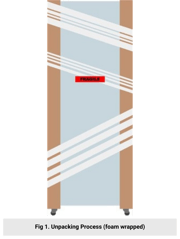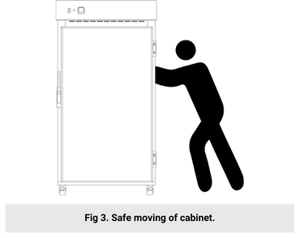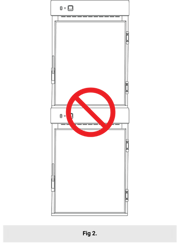Getting Started | Laboratory Ovens
Intended Use, Safety Guidelines, and Environmental Considerations
Applicable Models:
| TO-30G TO-150G TOH-150F |
|
📜 Quick Navigation
Intended Use
The Thermoline Laboratory Ovens TO-30G, TO-150G, and high-temperature TOH-150F models are designed and manufactured in Australia.
- TO Models: Ambient +10°C to 200°C
- TOH-150F Model: Ambient +10°C to 300°C
These ovens are commonly used for drying, baking, curing, heat treatment, and softening samples across industries like mining, technology, and primary industries. They use thermal convection for uniform heating. Natural convection ovens are economical and ideal for delicate samples, while fan-assisted convection ovens offer faster recovery and improved temperature uniformity.
Uncrating/Unpacking
Unpacking process for foam wrapped or boxed

 The TOH-150F and TO-150G models may be delivered foam-wrapped on their castors via sensitive freight (Fig 1) or in a box on a skid (Fig 2). The TO-30G model is only delivered in a box on a skid.
The TOH-150F and TO-150G models may be delivered foam-wrapped on their castors via sensitive freight (Fig 1) or in a box on a skid (Fig 2). The TO-30G model is only delivered in a box on a skid.
- If delivered on a skid, a forklift may be required to lift it off the skid.
- Please only dispose of the packaging once the the oven is inspected. If any damage is found, contact your supplier or Thermoline immediately at:
-
- Phone: +61 2 9604 3911
- Email: service@thermoline.com.au
Moving
Moving the oven on castors:
- Ensure that the oven is rolled on an even and flat surface. Uneven surfaces can cause the oven to fall over.
IMPORTANT
Laboratory ovens are 'Top Heavy'. Do not move the cabinet too quickly. (Fig 3 & 4)


Operating Environment
Laboratory Oven Location
- Place the oven away from direct sunlight and heat sources (e.g., heaters).
- Ensure the room's ambient temperature does not exceed the oven's operational limits.
- Laboratory ovens should be stored inside at all times. Failure to adhere to this could cause significant drops in cabinet performance and damage to items stored inside.
Environmental Conditions
| Condition | Temperature | Humidity |
| Extreme Operating Environment | 10°C to 32°C (±2.0°C) | Up to 85% RH |
| Optimal Environment | 23°C (±2.0°C) | 50% RH (±5% RH) |
Bench Top Location
- Under no circumstances should any ovens be stacked on top of each other (Fig. 2).
- Thermoline 150-litre ovens are equipped with removable castors for benchtop storage. To safely remove the castors, carefully tip the cabinet onto its back or side and unscrew the castors from the base (Fig. 3). This task requires two people—please seek assistance.

Electrical Connections
All laboratory ovens require a 10amp, 230V, 50Hz power supply
Important Notes
- Always use a dedicated outlet for the oven.
- Do not use power boards or extension cords to connect the oven.
The specific requirements for each model are shown in the table below:
| Model | Electrical Requirements |
|
TO-30G |
10A/230V |
Electrical Conditions

- All laboratory ovens include a 2.5m removable mains power lead with a three-pin plug. For models requiring a 15A connection, a straight plug is provided, while other models use a right-angle female IEC plug.
- Ensure the product is reasonably distanced from the power supply to prevent strain on the lead.
- Each oven features a male IEC socket for power connection.
 Operating Environment Warnings
Operating Environment Warnings
- Do not store items on top of the cabinet as this will also affect ventilation!
- CAUTION: When installing multiple cabinets in the same location, ensure they are positioned so that warm air exhausted from one cabinet is not drawn directly into another.
- Laboratory ovens should be stored inside at all times. Failure to adhere to this could cause significant drops in cabinet performance and damage to items stored inside.
- Laboratory ovens are not suitable for use with flammable solvents! They are fitted with components that may be the source of ignition.
- The laboratory ovens have exhaust vents and hot air will be discharged.
